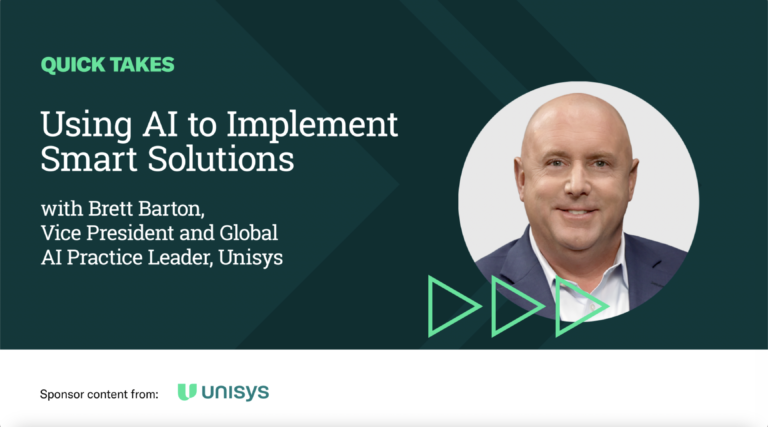Unisys is a global technology solutions company that helps the world’s leading companies thrive. Our solutions in cloud, AI, digital workplace, logistics and enterprise computing help our clients disrupt the status quo and realize their full potential. Click here for more information.
Todd Pruzan, HBR
Welcome to HBR Video Quick Take. I’m Todd Pruzan, senior editor, research and special projects, Harvard Business Review. Today I’m speaking with Brett Barton, global AI practice leader at Unisys, to explore the key artificial intelligence trends in today’s workplace. Brett talks about managing the pace of adoption in your organization as AI continues to evolve, what to prioritize in your short- and long-term AI adoption strategy, and determining the best business case for using this emerging technology. Thanks for joining us, Brett.
Brett Burton, Unisys
Thank you, Todd, for inviting me. I’m glad to be here.
Todd Pruzan, HBR
So, Brett, given that AI technology is evolving so quickly, how can organizations ensure they don’t fall behind in their AI adoption efforts?
Brett Burton, Unisys
Great question, Todd. As these new technologies are introduced, often very rapidly or even on a weekly basis, the older technologies become less capable, insightful, and intuitive. That’s why we encourage our clients to not get hung up on the technology itself, but to focus on the business case for AI that is most valuable to their goals and can achieve a tangible ROI. Ultimately, success requires leveraging an organizational change management program to encourage and train employees to change the way they work and get the most out of the technology innovations that are built.
Todd Pruzan, HBR
Brett, new AI-powered solutions and toolkits are constantly emerging. Is it worth it for an organization to build out their technology stack with multiple AI-powered solutions, or choose an ala carte option?
Brett Burton, Unisys
For organizations that are overwhelmed by their AI environment or don’t know where to start, ala carte options can be an attractive option, but the backend of these ala carte solutions has a lot of complex onboarding activities, systems, application integrations, security measures, and data access that are not components of the ala carte solution and must be thought through and solved by the organization.
A well-integrated technology stack will ultimately make it easier to adopt an AI solution, as it often comes ready to use, robust, and ready to handle all the integrations.
Todd Pruzan, HBR
Now, once your organization has identified the use cases for implementing an AI solution, what else should it incorporate into its short-term and long-term strategy?
Brett Burton, Unisys
AI implementation often depends on the success of the considered use cases and therefore needs to be understood by users and thoroughly evaluated. Then, finally, the ROI needs to be accurately calculated to ensure that business value is being realized. In addition, data maturity, quality assurance, security, and finally organizational change management are needed to ensure that end users are taking full advantage of the technological innovation and that the ROI is being realized. Finally, do not underestimate the need for patience to be continually applied, as AI solutions will mature and change over time.
Todd Pruzan, HBR
Well, Brett, thank you so much for sharing your insights with us today about the ever-expanding world of AI.
Brett Burton, Unisys
Thank you so much, Todd, for having me. It’s been a pleasure having you with me today.
Todd Pruzan, HBR
We spoke with Brett Barton, Global AI Practice Leader at Unisys Corporation.
For more information, click here: Business Leaders on AI Adoption: An HBR Report Sponsored by Unisys.



